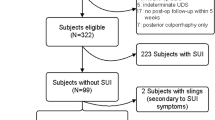Abstract
The aim of this study is to describe results of reduction testing in stress-continent women undergoing sacrocolpopexy and to estimate whether stress leakage during urodynamic testing with prolapse reduction predicts postoperative stress incontinence. Three hundred twenty-two stress-continent women with stages II–IV prolapse underwent standardized urodynamics. Five prolapse reduction methods were tested: two at each site and both performed for each subject. Clinicians were masked to urodynamic results. At sacrocolpopexy, participants were randomized to Burch colposuspension or no Burch (control). P-values were computed by two-tailed Fisher’s exact test or t-test. Preoperatively, only 12 of 313 (3.7%) subjects demonstrated urodynamic stress incontinence (USI) without prolapse reduction. More women leaked after the second method than after the first (22% vs. 16%; p = 0.012). Preoperative detection of USI with prolapse reduction at 300ml was pessary, 6% (5 of 88); manual, 16% (19 of 122); forceps, 21% (21 of 98); swab, 20% (32 of 158); and speculum, 30% (35 of 118). Women who demonstrated preoperative USI during prolapse reduction were more likely to report postoperative stress incontinence, regardless of concomitant colposuspension (controls 58% vs. 38% (p = 0.04) and Burch 32% vs. 21% (p = 0.19)). In stress-continent women undergoing sacrocolpopexy, few women demonstrated USI without prolapse reduction. Detection rates of USI with prolapse reduction varied significantly by reduction method. Preoperative USI leakage during reduction testing is associated with a higher risk for postoperative stress incontinence at 3 months. Future research is warranted in this patient population to evaluate other treatment options to refine predictions and further reduce the risk of postoperative stress incontinence.
Similar content being viewed by others
References
Richardson DA, Bent AE, Ostergard DR (1983) The effect of uterovaginal prolapse on urethrovesical pressure dynamics. Am J Obstet Gynecol 146(8):901–905
Bump RC, Fantl JA, Hurt WG (1988) The mechanism of urinary continence in women with severe uterovaginal prolapse: results of barrier studies. Obstet Gynecol 72(3 Pt 1):291–295
Meschia M, Pifarotti P, Spennacchio M, Buonaguidi A, Gattei U, Somigliana E (2004) A randomized comparison of tension-free vaginal tape and endopelvic fascia plication in women with genital prolapse and occult stress urinary incontinence. Am J Obstet Gynecol 190(3):609–613
Rosenzweig BA, Pushkin S, Blumenfeld D, Bhatia NN (1992) Prevalence of abnormal urodynamic test results in continent women with severe genitourinary prolapse. Obstet Gynecol 79(4):539–542
Wall LL, Hewitt JK (1994) Urodynamic characteristics of women with complete posthysterectomy vaginal vault prolapse. Urology 44(3):336–341discussion 41–42
Liang CC, Chang YL, Chang SD, Lo TS, Soong YK (2004) Pessary test to predict postoperative urinary incontinence in women undergoing hysterectomy for prolapse. Obstet Gynecol 104(4):795–800
Klutke JJ, Ramos S (2000) Urodynamic outcome after surgery for severe prolapse and potential stress incontinence. Am J Obstet Gynecol 182(6):1378–1381
Chaikin DC, Groutz A, Blaivas JG (2000) Predicting the need for anti-incontinence surgery in continent women undergoing repair of severe urogenital prolapse. J Urol 163(2):531–544
Brubaker L, Cundiff G, Fine P, Nygaard I, Richter H, Visco A et al (2003) A randomized trial of colpopexy and urinary reduction efforts (CARE): design and methods. Control Clin Trials 24(5):629–642
Brubaker L, Cundiff GW, Fine P, Nygaard I, Richter HE, Visco AG et al (2006) Abdominal sacrocolpopexy with Burch colposuspension to reduce urinary stress incontinence. N Engl J Med 354(15):1557–1566
Bump RC, Mattiasson A, Bo K, Brubaker LP, DeLancey JO, Klarskov P et al (1996) The standardization of terminology of female pelvic organ prolapse and pelvic floor dysfunction. Am J Obstet Gynecol 175(1):10–17
Diokno AC, Brock BM, Brown MB, Herzog AR (1986) Prevalence of urinary incontinence and other urological symptoms in the noninstitutionalized elderly. J Urol 136(5):1022–1025
Bruce RG, El-Galley RE, Galloway NT (1999) Paravaginal defect repair in the treatment of female stress urinary incontinence and cystocele. Urology 54(4):647–651
Colombo M, Vitobello D, Proietti F, Milani R (2000) Randomised comparison of Burch colposuspension versus anterior colporrhaphy in women with stress urinary incontinence and anterior vaginal wall prolapse. BJOG 107(4):544–551
Crystle CD, Charme LS, Copeland WE (1971) Q-tip test in stress urinary incontinence. Obstet Gynecol 38(2):313–315
Barber MD, Kuchibhatla MN, Pieper CF, Bump RC (2001) Psychometric evaluation of 2 comprehensive condition-specific quality of life instruments for women with pelvic floor disorders. Am J Obstet Gynecol 185(6):1388–1395
Veronikis DK, Nichols DH, Wakamatsu MM (1997) The incidence of low-pressure urethra as a function of prolapse-reducing technique in patients with massive pelvic organ prolapse (maximum descent at all vaginal sites). Am J Obstet Gynecol 177(6):1305–1313 discussion 13–14
Gallentine ML, Cespedes RD (2001) Occult stress urinary incontinence and the effect of vaginal vault prolapse on abdominal leak point pressures. Urology 57(1):40–44
Romanzi LJ (2002) Management of the urethral outlet in patients with severe prolapse. Curr Opin Urol 12(4):339–344
Bhatia NN, Bergman A, Gunning JE (1983) Urodynamic effects of a vaginal pessary in women with stress urinary incontinence. Am J Obstet Gynecol 147(8):876–884
Nygaard I (1995) Prevention of exercise incontinence with mechanical devices. J Reprod Med 40(2):89–94
Bergman A, Koonings PP, Ballard CA (1988) Predicting postoperative urinary incontinence development in women undergoing operation for genitourinary prolapse. Am J Obstet Gynecol 158(5):1171–1175
Bump RC, Hurt WG, Theofrastous JP, Addison WA, Fantl JA, Wyman JF et al (1996) Randomized prospective comparison of needle colposuspension versus endopelvic fascia plication for potential stress incontinence prophylaxis in women undergoing vaginal reconstruction for stage III or IV pelvic organ prolapse. Am J Obstet Gynecol 175(2):326–333 24, discussion 33–35
Haessler AL, Lin LL, Ho MH, Betson LH, Bhatia NN (2005) Reevaluating occult incontinence. Curr Opin Obstet Gynecol 17(5):535–540
Conflicts of interest
None.
Author information
Authors and Affiliations
Consortia
Corresponding author
Rights and permissions
About this article
Cite this article
Visco, A.G., Brubaker, L., Nygaard, I. et al. The role of preoperative urodynamic testing in stress-continent women undergoing sacrocolpopexy: the Colpopexy and Urinary Reduction Efforts (CARE) randomized surgical trial. Int Urogynecol J 19, 607–614 (2008). https://doi.org/10.1007/s00192-007-0498-2
Received:
Accepted:
Published:
Issue Date:
DOI: https://doi.org/10.1007/s00192-007-0498-2




